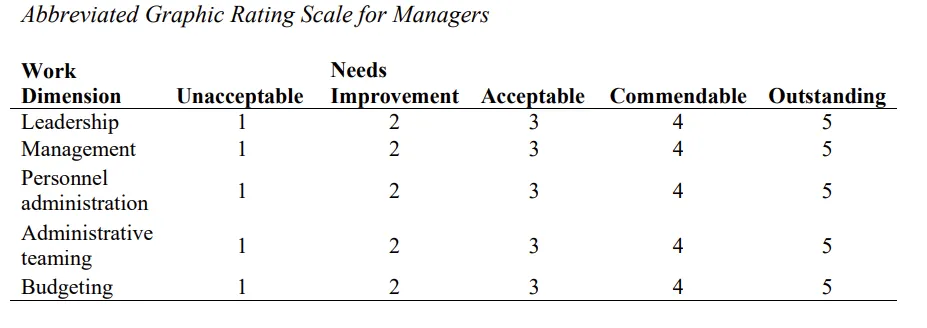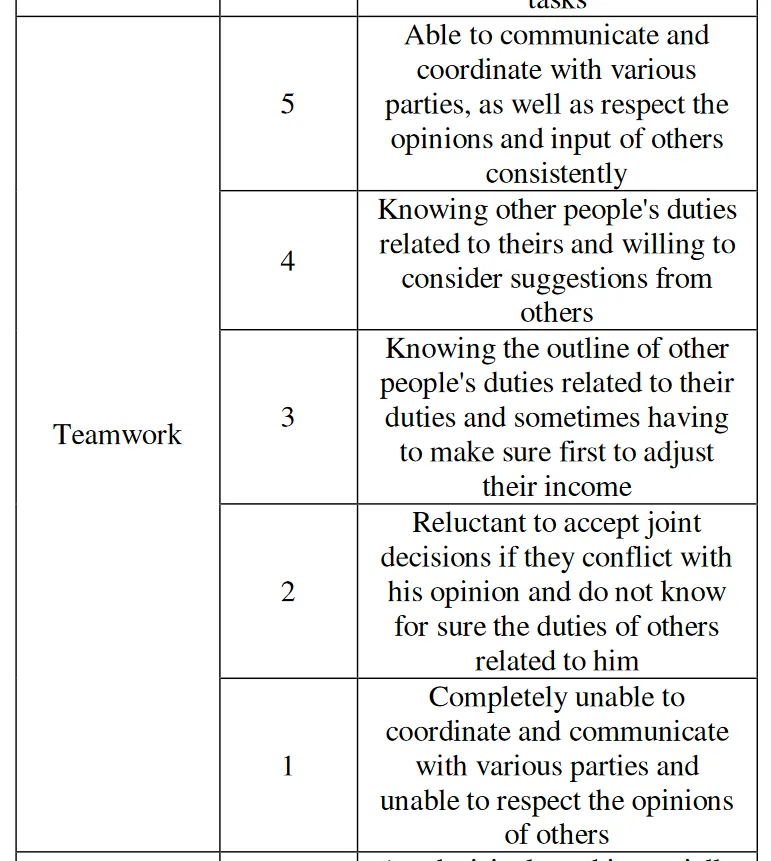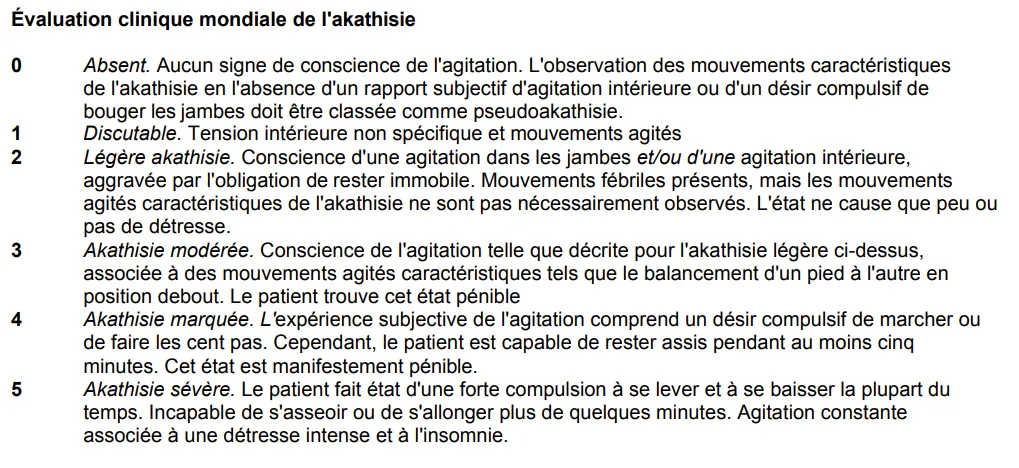In this brief article, we’ll take a quick tour of the three families of candidate evaluation methods in the recruitment sector, before focusing on one in particular: the BARS scales.
(Disclaimer: This article attempts to popularize and simplify concepts from HR literature to offer applicable solution paths to current HR issues faced by companies and the job market.)
I. Traits Methods (or judgment-based evaluation methods)
These are methodologies based on the subjective judgment of the person in charge of evaluating candidates. They aim to compare people to others or in relation to a given situation. While several exist, only one is widespread in the recruitment sector: the Graphic Rating Scale.
Very common, this methodology aims to evaluate the interview or experience with a candidate according to a grid of subjective level criteria, as shown in this example:

Figure 1: Example of a Graphic Rating Scale used to evaluate different dimensions of work (Leadership, Management, Administration, etc.).
Although simple to implement, this method suffers from a lack of standardization among recruiters and companies and remains very subjective. (2) Moreover, like all Traits Methods, their dependence on the evaluator’s subjectivity makes them particularly sensitive to cognitive biases (especially leniency and severity biases and halo effect), making them more difficult to use.
II. Results evaluation methods
Much more used in performance management than in recruitment, this family of methods focuses solely on the employee’s results for specific tasks, without considering the context in which these tasks are performed. They are therefore one-dimensional. (1)
For example, a recruiter might focus solely on the revenue generated by a candidate for a sales position, without taking into account favorable or unfavorable contexts from their previous position, previous contract, or previous work experience in general, such as resources made available, geographical area, or local labor market conditions.
However, they are objective, and several behavior-based evaluation methods rely on Results Methods.
III. Behavioral methods
Behavioral Methods evaluate an individual’s or employee’s behavior in a given context, comparing it to a predefined standard. (1)
There are several of these, including the critical incident method, the STAR method, or the one we’re particularly interested in here: BARS (Behavioral Anchoring Rating Scale)
a. Focus on behavioral scales (BARS)
Introduced in 1963 by Smith and Kendall, BARS were developed to increase the accuracy and objectivity of candidate evaluations. The recruiter (or Hiring Manager) takes on the role of an observer rather than a judge during the job interview. They are based on precise and factual criteria, often derived from the critical incident method. (3)
The BARS scale then describes different levels of competence based on the behavior observed during the performance of a task or missions by the candidate. However, these scales are not only used in Human Resources and Recruitment, but also in other fields, particularly medical (and more specifically in psychiatric professions). Below are two examples of BARS scales taken from a case study of employee skills assessment (Figure 2) and the Barnes Akathisia Rating Scale (Figure 3)

Figure 2: Example of a BARS scale applied to the evaluation of teamwork skills.

Figure 3: Barnes scale for global clinical evaluation of akathisia.
b. The advantages of BARS
Transferability: As visible in figure 3, one of the strengths of BARS is its objectivity and replicability. It’s independent of the observer’s judgment, and thus becomes transferable across candidates and job offers, presenting a reference framework.
Completeness of evaluation: BARS allow for the evaluation of both hard skills and soft skills (6), thus providing additional information that’s difficult to obtain through results-based evaluation methods.
Acceptability: Thanks to their objectivity, BARS are often better accepted by employees, and probably also by candidates in recruitment. By reducing subjectivity and relying on clear and precise criteria, they facilitate the buy-in of the person being evaluated and companies, regardless of profiles, position, or targeted job.
Legal protection: In the fight against discrimination, companies must be able to demonstrate that their recruitment practices are based exclusively on the skills required for a given position. Thanks to their precision, BARS facilitate this proof by showing that recruitment or non-recruitment decisions are strictly based on the skills and talents of the candidate or employees.
c. The limitations of BARS
Implementation: This is undoubtedly their biggest limitation. While implementing BARS doesn’t add much material cost, it’s very time-consuming. To benefit from its advantages, BARS must be carefully created by HR teams with consensus from stakeholders on the criteria and critical incidents that compose them.
Immutability: This is the corollary of their transferability and the time cost of implementation. By setting an objective reference framework, BARS make changes and modifications costly. Work environments or sectors where jobs and tasks evolve rapidly are therefore not very suitable for their use.
IV. Conclusion
Recognized for their objectivity and ability to reduce bias, BARS have established themselves as a valuable tool for professional evaluations. However, their complexity of implementation within teams still limits their adoption, particularly in environments and sectors where tasks and processes evolve rapidly.
To overcome these obstacles, companies could explore hybrid approaches that combine the rigor of BARS with digital tools to simplify their implementation. As technology progresses, particularly through HR platforms and artificial intelligence systems, it becomes conceivable to design adaptive and less time-consuming evaluation solutions.
Finally, integrating BARS into targeted pilot projects could allow companies to test their effectiveness before wider adoption, while training teams in their use for effective recruitment.
Regardless of the evaluation method used in the company, whether in recruitment or performance management, it is essential to recognize its potential impact on employee motivation and engagement, regardless of their profile. Several theories, such as those related to organizational justice or perception of fairness, explore these dynamics. But these aspects would deserve another article to go further and explore in depth their impact on HR practices in companies.
V. Bibliography
Lunenburg FC. Performance Appraisal: Methods and Rating Errors.
Aggarwal A, Thakur GSM. Techniques of Performance Appraisal-A Review. 2(3).
Debnath SC, Lee BB, Tandon S. Fifty Years and Going Strong: What Makes Behaviorally Anchored Rating Scales So Perennial as an Appraisal Method? 2015;6(2).
Hadi K, Iskandar I, Ariqah M. Employee Performance Assessment with Behaviorally Anchor Rating Scale (BARS) Approach: A Case Study. 2022;7(7).
Barnes TR. A rating scale for drug-induced akathisia. Br J Psychiatry J Ment Sci. May 1989;154:672‐6.
Jacobs R, Kafry D, Zedeck S. Expectations of Behaviorally Anchored Rating Scales. Pers Psychol. Sept 1980;33(3):595‐630.

